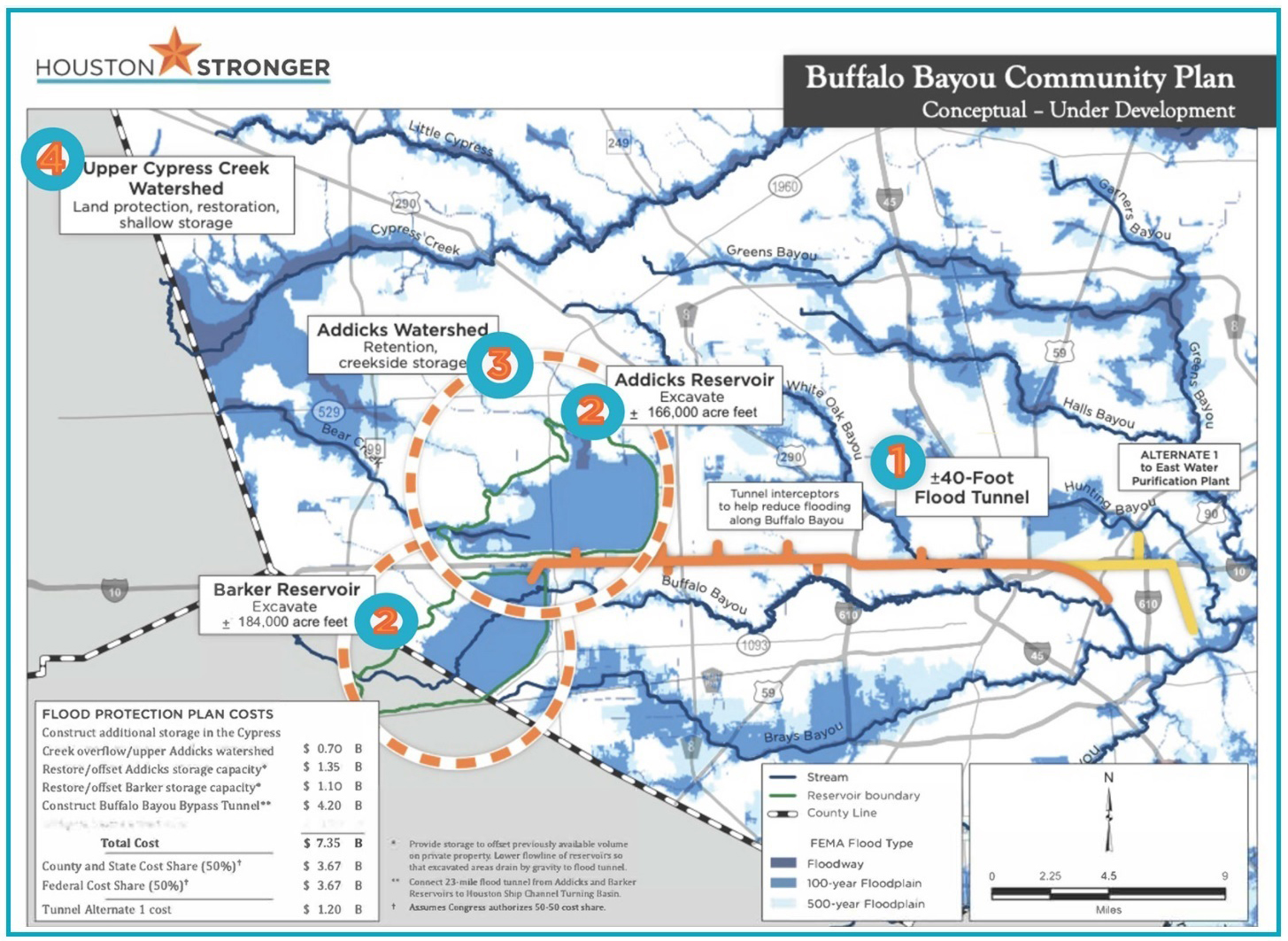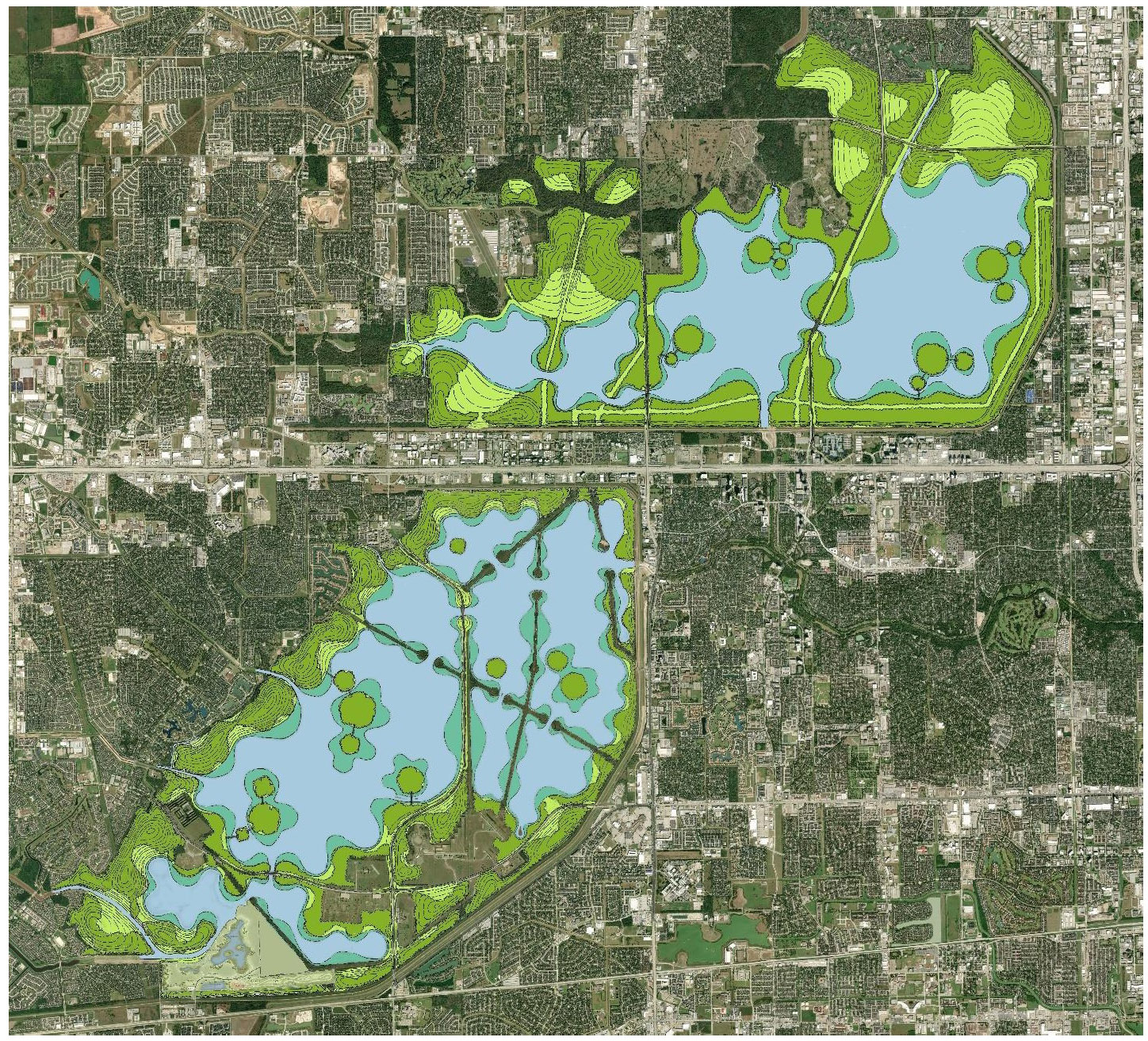By Tom Douglas
On January 18, the Katy Prairie Conservancy convened an Environmental Roundtable to receive input on the Buffalo Bayou Community Plan that it is developing in cooperation with the non-profit Houston Stronger to address flooding in the Buffalo Bayou Watershed.
The need for much greater community input into plans to deal with flooding was underscored by the highly controversial Interim Feasibility Report entitled “Buffalo Bayou and Tributaries Resiliency Study, Texas” that was released by the Army Corps of Engineers in October 2020. That report recommended the continued study of two alternatives that are of great concern to environmentalists: (1) excavating the channel of Buffalo Bayou out to a greater depth and width and lining it with articulated concrete blocks, and (2) constructing a large reservoir on the Katy Prairie that would have a huge impact on land that is being preserved by the Katy Prairie Conservancy. For a summary of the situation as it stood in late 2020, see the article that appeared in the November 2020 issue of the Bayou Banner newsletter.
Faced with an overwhelmingly negative response from the Sierra Club, other environmental organizations, and the business community, the Corps was forced to reconsider its options. The purpose of the January 18, 2022 meeting of the Environmental Roundtable was to receive community input that can help to move the planning process forward. The discussion focused primarily on the Addicks and Barker Reservoirs (Component 2 of the Buffalo Bayou Community Plan). A future meeting will address the “Flood Tunnel” concept (Component 1).
The Roundtable’s discussion was guided by a four-member panel, whose expertise is summarized at the end of this article. Augustus (Auggie) Campbell initiated the discussion by describing the four components of the Buffalo Bayou Community Plan, which are paraphrased below.

Component 1
Construct a tunnel capable of conveying flood waters from the Addicks and Barker Reservoirs to the Houston Ship Channel while avoiding impacts to, if not improving, water quality.
Component 2
Provide additional storage within the Addicks and Barker Reservoirs by reshaping them and doing additional excavation within their existing footprints. Material from the excavations can be used to create new topography, adding new ecological and recreational value.
Component 3
Construct more storage in the upper Addicks Watershed through small, dispersed ungated retention basins within the watershed, including along South Mayde Creek and Bear Creek.
Component 4
To prevent overflows from Cypress Creek into the Addicks Reservoir, create more flood water storage within the Upper Cypress Creek Watershed. Smaller, nature-based projects could include shallow depressional wetlands, providing detention along Cypress Creek, and expanding protected lands.
Larry Dunbar reported that as a result of Hurricane Harvey in August 2017, approximately 5,000 homes on the upstream (west) side of Addicks Reservoir were inundated and another approximately 5,000 homes were located lower than the maximum design pool, but escaped inundation. The maximum pool would have been approximately 6 feet higher than what was reached during Harvey. A similar situation obtained at the Barker Reservoir, where approximately 5,000 homes were inundated, and approximately 5,000 others were located lower than the maximum design pool, but escaped inundation. Had the track of Hurricane Harvey been farther to the west than it was, rainfall over these two reservoirs could have been significantly greater than the actual 30 inches. Later, in September 2019, Tropical Storm Imelda dropped 43 inches of rain, but that was not centered over this location. To date, the Army Corps of Engineers has been found to be liable for damages to 3 homes in each of these two reservoirs, with monetary damages to be adjudicated in March 2022. Much additional litigation is anticipated. To receive a pay-out, homeowners who choose to rebuild will have to grant a “permanent flowage easement,” the value of which is yet to be determined.

Kevin Shanley presented a preliminary reservoir storage analysis indicating that excavation within the Addicks and Barker Reservoirs could almost double their capacity. The assumptions behind this design differ from those of the Army Corps of Engineers’ Interim Report in three respects: (1) all excavated materials would be kept on site, (2) the reservoirs would be largely wet bottom pools, and (3) the wet bottom pools and their fringing freshwater emergent marshes would provide excellent habitat and recreational opportunities, and would significantly reduce maintenance costs. Projects at The Hill at Sims and Willow Waterhole Greenway were cited as examples of this general type of approach. Much design work and community involvement would be required to render this into a finished plan. The boundaries of the project would not extend beyond government-owned land, and demolition or relocation of existing buildings, roads, pipelines, and fiber optic cables would be held to a minimum. Nesting birds or endangered plant species could be protected, for example, on isolated islands.
Members of the Expert Panel
Augustus L. Campbell
President of Houston Stronger, a coalition of civic groups, business associations and citizens
Executive Director of the Association of Water Board Directors, Texas
Former Assistant City Attorney for the City of Houston, with responsibility for water-related issues
David Lowe
Principal of BGE, Inc., an electric and natural gas utility company
Broad experience in the planning and construction of projects related to water, transportation, and recreation
Larry Dunbar
Attorney and engineer
Project Manager with SSPEED Center and P.B. Bedient & Associates, Inc.
Experience with litigation over Hurricane Harvey flood damages
Kevin Shanley
Landscape Architect
Past CEO of SWA Group, an international landscape architecture, planning and urban design firm
Past Board Chairman of Bayou Preservation Association
Photo Credits:
Buffalo Bayou Flooding During Hurricane Harvey by U.S. Army Corps of Engineers
Buffalo Bayou Community Plan Map by Houston Stronger
Addicks & Barker Excavated & Reshaped Diagram by Kevin Shanley